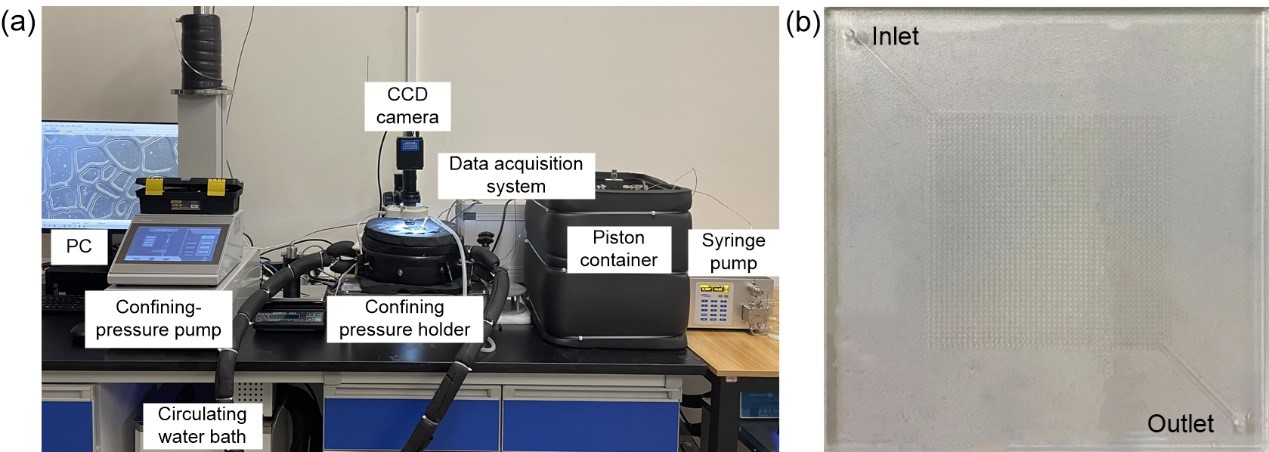Speaker
Description
Natural gas hydrates (NGH) are ice-like crystalline substances that consist of water molecules acting as host and methane guest molecules and formed at low temperature and high pressure 1. Methane hydrate (MH) has been considered a promising future energy source due to its vast resource volume and high energy density. Understanding the behavior of MH formation and dissociation at pore-scale and the effect of MH distribution on the gas-liquid two phase flow is of critical importance for designing effective production strategies from NGH reservoirs 2. The phase change of NGH from a gas-liquid two-phase system, the evolution of NGH morphology, and the distribution of NGH at the pore-scale provide critical insights into understanding the underlying thermal-hydraulic-mechanical-chemical process [3]. Additionally, depressurization method has garnered significant research attention over the past decades and is widely considered the most promising approach due to its high energy efficiency [4]. This warrants the development of novel experimental techniques to provide direct visual evidence for MH formation and depressurization-induced dissociation and the evolution of gas bubbles in pores.
In this study, we devised a novel high-pressure microfluidic chip apparatus that is capable of direct observation of MH formation and dissociation behavior at pore scale. Fig. 1a shows the experimental apparatus for pore-scale investigation on the microfluidic chip. The entire apparatus consists of four major components: a) a confining pressure holder; b) an etched microfluidic chip, as shown in Fig. 1b; c) a constant flow-rate syringe pump; d) a high-resolution charge-coupled device camera. MH nucleation and growth were conducted under same conditions with Shenhu Sea, South China Sea (P = 15.0 MPa, T = 276.2 K). Depressurization was used to induce MH dissociation at three different BHP of 12.0, 10.0, 8.0 MPa with constant pressure drawdown rates of 7.0 MPa/h at T = 287.7 K.

Fig. 1. (a) picture of the in-house made high-pressure microfluidic; (b) the microfluidic chip used in this study.
Fig .2 shows the evolution of P and T, and MH morphology and gas bubbles during MH dissociation under depressurization. Our experimental results reveal that two types MH formation mechanisms co-exist in pores: (a) porous-type MH formed from CH4 gas bubbles; and (b) crystal-type MH formed from dissolved CH4 gas. Crystal-type MH is relatively stable and its dissociation pressure is lower than that of porous-type MH. MH dissociation in the pores produce obvious aggregation and coalescence, and converge into a continuous gas phase flowing within the pores under depressurization. The experimental results from our study aim to provide a direct pore-scale observation of NGH formation and dissociation and provide a fundamental understating of gas-liquid two phase flow.

Fig .2. (a) Evolution of P of microfluidic chip; and (b) evolution of MH morphology and gas bubbles during MH dissociation under depressurization.
| References | [1] Yin Z, Khurana M, Tan HK, Linga P. A review of gas hydrate growth kinetic models. Chemical Engineering Journal. 2018; 342:9-29. [2] Zhang J, Yao Y, Yin Z. Fluid production from NGH reservoir: fundamental physics, numerical model, and reservoir simulation. Challenges and Recent Advances in Sustainable Oil and Gas Recovery and Transportation: Elsevier; 2023. p. 53-80. [3] Mahabadi N, Jang J. Relative water and gas permeability for gas production from hydrate‐bearing sediments. Geochemistry, geophysics, geosystems. 2014;15(6):2346-53. [4] Zhang J, Yin Z, Li Q, Li S, Wang Y, Li X. Comparison of fluid production between excess-gas and excess-water hydrate-bearing sediments under depressurization and its implication on energy recovery. Energy. 2023;282, 128315. |
|---|---|
| Country | China |
| Conference Proceedings | I am interested in having my paper published in the proceedings. |
| Student Awards | I would like to submit this presentation into both awards |
| Acceptance of the Terms & Conditions | Click here to agree |




.jpg)
